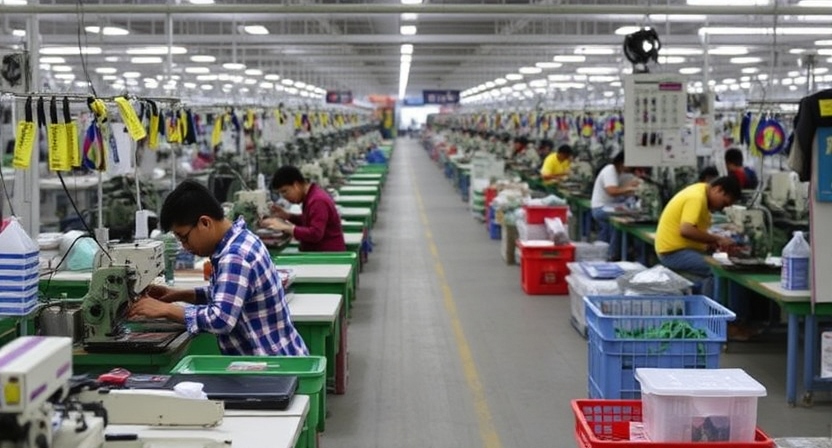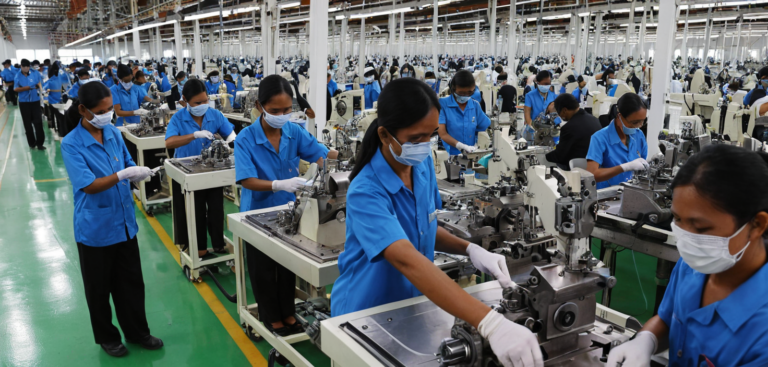Cambodia’s manufacturing sector has witnessed extraordinary growth over the past few decades, transforming from a modest industry into a significant driver of economic prosperity. Once limited to just 68 factories in 1997, the garment, footwear, and travel goods sector has now expanded to an impressive 1,326 factories in 2023. This growth has led to the creation of over 840,000 jobs, marking a remarkable transformation for the country.
Prime Minister Hun Sen recently attributed the substantial growth of Cambodia’s manufacturing sector to the country’s enduring peace and political stability. During an address at the Royal Group Phnom Penh Special Economic Zone, he highlighted that political stability has been a key factor in attracting both domestic and foreign investors. Cambodia’s peaceful environment, combined with a commitment to sustainable development and industrialization, has played a critical role in fostering local production while simultaneously expanding the country’s export capacity.
The garment, footwear, and travel goods sector remains Cambodia’s largest foreign exchange earner and continues to drive significant economic growth. In 2023, this industry is expected to grow by 9.2%, fueled by strong external demand from key markets such as the United States, the European Union, and Southeast Asian countries like Myanmar. The garment sector alone is projected to grow by 8.1%, further contributing to the country’s export volume and overall economic prosperity.
This growth in the manufacturing sector is critical to Cambodia’s overall economic trajectory. The country’s GDP is projected to expand by 6.6% in 2023, surpassing initial growth forecasts. This positive outlook is largely supported by strong global demand, improving investor confidence, and the gradual recovery from the impacts of the COVID-19 pandemic.
To counter the impact of inflation and ensure sustained economic growth, Cambodia’s government has prioritized policies to mitigate inflationary pressures while fostering domestic investment. Inflation is forecast to decrease to 2.5% in 2023, down from 5% in 2022. The government is also considering expanding intervention packages to further stabilize the economy and ensure job creation.
Foreign Direct Investment (FDI) is expected to recover in 2022 and 2023, reaching 12% and 11.6% of Cambodia’s GDP, respectively. This recovery is supported by shifting regional and global production and supply chains, as well as improved investor confidence. The growth in FDI will help Cambodia maintain stable foreign reserves, projected to reach $22 billion in 2023, providing the country with a solid foundation to support imports and overall economic stability.
While Cambodia’s manufacturing sector is experiencing remarkable growth, the agricultural sector remains vital to the country’s economic stability. In 2023, the agriculture industry is projected to grow by 1.1%, with particular strength in animal husbandry, plantations, and fisheries. The export of agricultural products, especially mixed and agro-industrial goods, is expected to continue playing a significant role in supporting the country’s growth.
The government’s emphasis on modernizing agriculture and improving productivity will ensure that this sector remains a crucial contributor to Cambodia’s long-term economic development. Agricultural growth, in tandem with the expansion of manufacturing, will help create a balanced and diversified economy that is better equipped to weather global economic fluctuations.
The remarkable growth of Cambodia’s manufacturing sector—especially in garments, footwear, and travel goods—serves as a testament to the country’s enduring peace and political stability. The consistent expansion of this sector is not only providing valuable jobs but also positioning Cambodia as an increasingly important player in the global manufacturing landscape.
As Cambodia continues to prioritize stability, investment, and growth across various sectors, the country is poised for long-term prosperity. The combination of strong government policies, an investor-friendly environment, and a diversified economy will ensure that Cambodia remains a competitive force in Southeast Asia.
Cambodia’s manufacturing sector stands as a powerful symbol of the nation’s economic transformation and resilience. With a solid foundation built on peace, political stability, and favorable investment policies, Cambodia is well on its way to becoming one of the leading manufacturing hubs in Asia. The country’s focus on attracting investment, boosting domestic production, and expanding its export capacity will continue to propel its economic growth.
Looking forward, Cambodia’s economy will need to maintain a delicate balance between supporting industrial growth and strengthening other sectors such as agriculture. By doing so, Cambodia will be able to build a more diversified and resilient economy that can compete globally and provide sustainable prosperity for its people. With its manufacturing sector at the forefront, Cambodia is positioning itself to be a key economic player in the ASEAN region and beyond.

